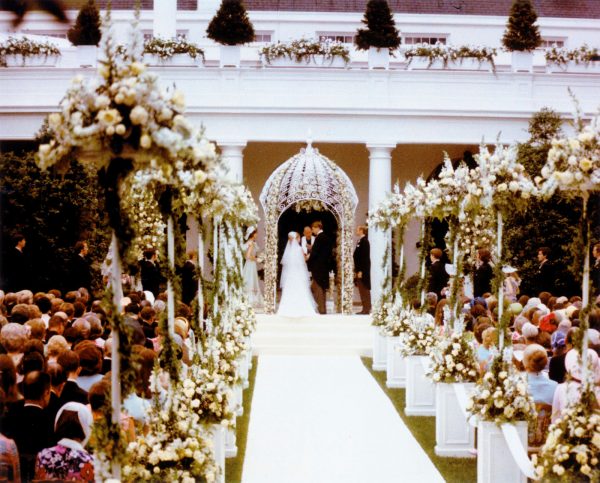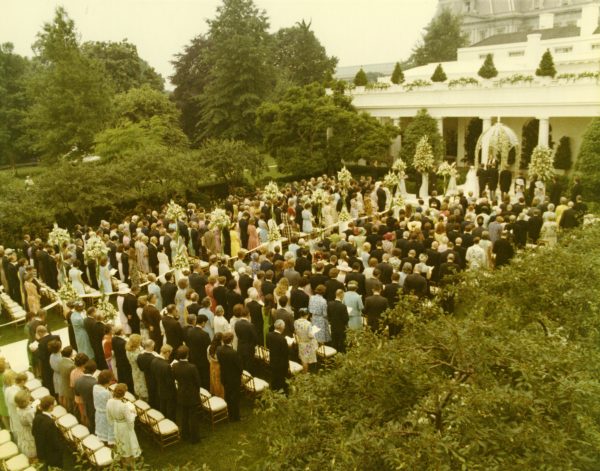
The White House Rose Garden has been a mainstay in America for over half of a century. Originally created as backdrop for the most historic and iconic moments in American history it has also hosted some of our first families most personal, humanizing moments as well. Providing great refuge for our heads of state, this architectural gem held within the 18 acres that makes up the White House grounds is like no other place, making it the perfect location to host one of America’s greatest weddings 50 years ago for Patricia Nixon Cox.
This amazing stage for media events and receptions was created by Bunny Mellon at the request of President and Mrs. Kennedy. President Kennedy, according to Meryl Gordon, believed “the garden looked forlorn and outdated. He wanted to apply his campaign slogan – “We Can Do Better”- to the White House Grounds,” and they did, not just to the garden, but to the entire White House.
Legendary event planner Bryan Rafanelli, not only orchestrated Chelsea Clinton’s wedding but also designed many significant events for the Obama White House, recently told me, “there are a lot of fantasies out there of where one would want to be married, but there is no better setting than the White House Rose Garden. It is one of the few places in the world that could truly never be replicated”. President Richard Nixon and First Lady Pat Nixon’s elder daughter, Tricia, agrees and is the only daughter of a commander and chief to have exchanged vows in the artfully planned space.

To this day, a wedding remains one of the most lovely and rare celebrations to take place at the People’s House. In the past 60 years, only two first daughters have wed at 1600 Pennsylvania Avenue: Lynda Bird Johnson, daughter of President Lyndon B. Johnson, and Tricia Nixon, daughter of President Richard Nixon. (Lynda Bird’s sister, Luci Baines, held a reception at the White House following a church ceremony.) Two other first daughters got married while their fathers were in office, although they didn’t exchange vows at the White House. Dorothy Bush, daughter of President George H.W. Bush, held her wedding at Camp David. President George W. Bush’s daughter (and Dorothy’s niece) Jenna Bush got married at her family’s ranch in Crawford, Texas, but hosted a party at the White House shortly thereafter, Nixon is the only to do so within those significant hedges. And Nixon’s sister, Julie Nixon Eisenhower, married David Eisenhower after her father’s election in 1968 but before his inauguration.
President Nixon wrote in his memoirs “We asked Tricia if she would like to have a White House wedding. It was entirely up to her and Ed, but we felt it would be something they would remember all their lives”. And it was something that they did want to do. When I spoke with Tricia, she vividly recalled walking out on a cold December night though the Rose Garden with her then fiancé. The Garden had just been perfectly covered with snow and it held a “magical- fairy tale quality” to it. The fresh snow was reflecting the iconic flood lights that her mother had recently installed (so that all those passing could enjoy the People’s House). The couple decided that evening that it would be a perfect place for them to exchange vows.
For the Bride and her family, it was simply a wonderful wedding that Tricia recalls as an “oasis of beauty and tranquility.” Famed White House Social Secretary Letitia Baldridge probably described the wedding best, “Every aspect of the wedding reflected the spring- garden theme- from the organdy- brimmed picture hats of the four bridal attendants to the profusion of lilacs, peonies, roses and other spring flowers indoors and out”. Most importantly, however, it was a day that the Bride and Groom will never forget and one that the entire family remembers as “one of their happiest in the White House.”
The scale of the Rose Garden ties beautifully with the White House. For one, of the strengths of the People’s House is its composition. Tricia says, “it was built on a human scale, it sometimes surprises both visitors and even Heads of State, that it is smaller than they expected but that is part of its allure”. Every aspect of the garden was taken into consideration for the design for the nuptials. Famed florist, horticulturist, and Nixon friend J. Liddon Pennock of Philadelphia was brought in to help create and oversee the nearly one hundred volunteers for the wedding. Chairs for the guests were placed in rows to create a center aisle leading to a perfectly situated ironwork gazebo altar that was fashioned in the White House metal shop. The scale of the garden was even taken into account with the Bride’s dress. Tricia remembers her and Priscilla Kinder (famed bridal gown designer known as Priscilla of Boston) cutting her train slightly to ensure that the gown too matched the symmetry of the Garden (it fell between a Court and Chapel length).
Less than a year later First Lady Pat Nixon opened the White House Rose Garden to all, April 14, 1973, hosting the first White House Garden Tour, a tradition upheld to this day. She was one of the greatest champions of the People’s House, believing that the beauty and history of the President’s House should both be restored and made more accessible to the general public, which they successfully achieved.
Much discussion of the Rose Garden has taken place in recent months, with those that champion the renovations of First Lady Melania Trump and those that consider some of the change’s sacrilege (Trump who used the garden often undertook the first major renovation of the White House Rose Garden in years, working with the Committee for the Preservation of the White House, the Committee for the Preservation of the White House Grounds and additional advisors to make much needed structural improvements while keeping the garden close to Bunny Mellon’s original design). All must agree however that it is one of America’s most beloved and recognizable gardens. Linda Jane Holden, a garden historian, authority on the Rose Garden, the life of Bunny Mellon and former member of Nancy Reagan’s staff, said to me that Bunny “wanted to create a garden that would enhance the architecture of the White House”. In so doing she created the most unique setting at 1600 Pennsylvania Avenue, where you are surrounded by history without being overwhelmed by it. When inside one is in awe while equally calmed by the natural beauty it provides. The amazing exterior of the White House, the ornamental carved stone ordered by Washington, the colonnade added by Thomas Jefferson leading to the West Wing- the symbolism cannot be escaped, reminding you that you are in the seat of power. Yet it is all quieted by the horticulture strategically planted.
Simultaneously the layout of the garden also provides rare privacy within grounds thanks to it’s calculated bounty. Heather Cooper, White House florist for Bush, Obama and Trump and now lead designer at Blair House, the President’s guest house across Pennsylvania Avenue, who has worked on countless events inside the President’s Garden describes it to me as a “sanctuary” “almost a secret garden.” It was a setting that offered a sense of occasion that nothing else could compare for both the Bride and her guests.
Prominent interior designer Bryan Huffman, who was a close confidant of Mellon’s, and has co-authored a book on her told me “Bunny was thrilled the garden was not just used just for ceremonial purposes but also for personal ones for first families, including the Nixon wedding”. And her garden was in full bloom that day. White House florist during the Nixon administration, Dottie Temple wrote “Nature helped the Rose Garden by sprouting many pretty flowers, including regal and Madonna lilies, white peonies, geraniums, petunias, and bridal wreath spirea. Additional flowers by the volunteers were added, topiaries of flowers complementing those in the garden’s bloom were strategically placed. Additionally, the flower arrangements created by the volunteers were so stunning that day that the President even wrote of them, the “flowers which were exquisite in their own right were intertwined with one another, and out of this composition emerged a creation of beauty that surpassed the beauty of the individual flowers. For once, mankind had improved on nature”. (Following the wedding all the flowers were taken to Washington area hospitals and homes for the elderly).
The Rose Garden continues to be that sanctuary to the President, just outside the Oval Office but it also still stands as a very public spot for the American people to share in historic moments with the President and First Lady. Whether it is major announcements, ceremonies, state dinners or weddings, the impact of Bunny Mellon’s design still holds strong, no matter the season, no matter the occupant, the Rose Garden will always flourish.
Thomas Lloyd, grandson to Bunny Mellon, recalled to me that his grandmother Bunny Mellon wanted to design “a space for everyone to enjoy” and she succeeded. Fifty years later Presidents, visiting Heads of State, First Families and even the public continue to enjoy The Rose Garden and the vision created over 60 years ago.
—
Jennifer Boswell Pickens is a historian focusing on first ladies and the White House. She is a public speaker and author of three books, “Christmas at the White House,” “Pets at the White House,” and her latest book, “Entertaining at the White House: Decades of Presidential Traditions.” Follow her on Instagram @jenniferbpickens and Twitter @JenniferPickens


